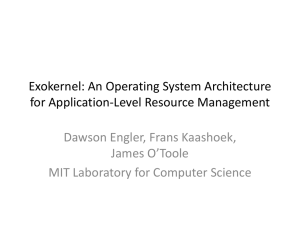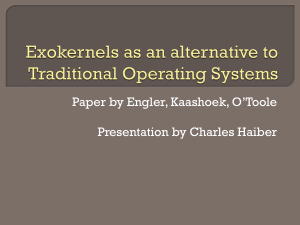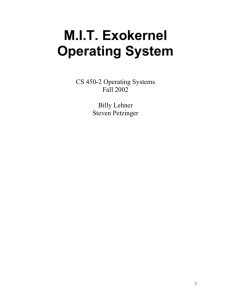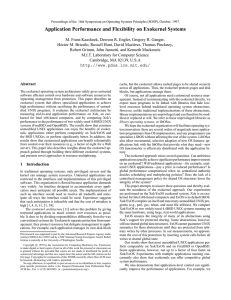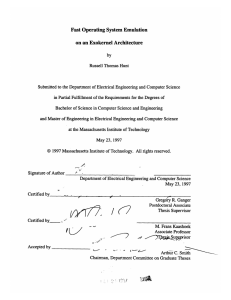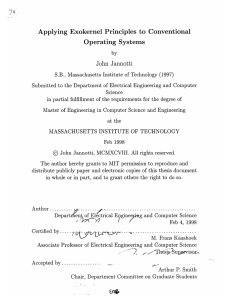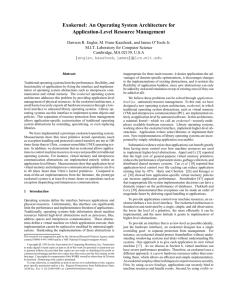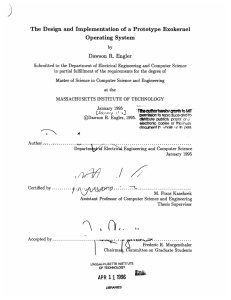ppt
advertisement
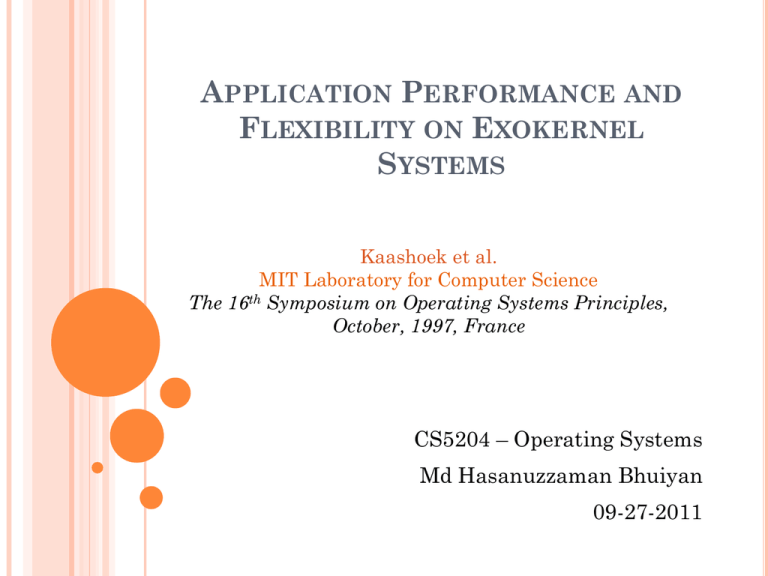
APPLICATION PERFORMANCE AND FLEXIBILITY ON EXOKERNEL SYSTEMS Kaashoek et al. MIT Laboratory for Computer Science The 16th Symposium on Operating Systems Principles, October, 1997, France CS5204 – Operating Systems Md Hasanuzzaman Bhuiyan 09-27-2011 CONTENT Introduction Traditional OS Monolithic kernel and Microkernel Exokernel Performance Evaluation Example File System Conclusion Discussion 2 TRADITIONAL OS Only privileged servers and the kernel can manage system resources Both resource management and protection are done by kernel Centralized control Untrusted applications are limited to the interface Limited functionality Hurt application performance Hide information (page fault etc.) 3 TRADITIONAL OS An interface designed to accommodate every application must anticipate all possible needs Flawed ! Solution: Allow applications enough control over resources by separating protection from management “Exokernel” does this ! User process User process System calls Kernel 4 MONOLITHIC KERNEL Kernel takes care of almost all the system tasks Applications do not have control over resources Example: Windows 9x series: Windows 95, 98 BSD: FreeBSD, OpenBSD Linux 5 Ref: Kaashoek et al. MICROKERNEL Runs most of the operating system services at the user space. Parts that require privilege (IPC, etc) are in kernel mode and other critical parts (FS, Network Stack) in user mode. Example: L4 microkernel Performance issue ! 6 Ref: Tanenbaum’s distributed systems. EXOKERNEL Separates resource management from protection Kernel Normal kernel does both protect the resources Application Manage the resources Virtual memory, file system etc. are in application libraries Gives untrusted software as much control over hardware and software resources as possible Specialized applications can gain high performance without sacrificing the unmodified UNIX program 7 EXOKERNEL: EXAMPLE Application manages its disk-block cache and kernel allows cached pages to be shared securely between applications User space Kernel space 8 MICROKERNEL VS. EXOKERNEL Microkernel Exokernel Process module Microkernel Microkernel Hardware System Call File module User space Memory module Kernel space User process Kernel User No direct data exchange between modules 9 EXTENSIBLE OPERATING SYSTEMS Extensibility lets new functionalities to be included in the operating systems Goal is to let applications safely modify system behavior for the applications’ own need Different approaches to extensible OS: Exokernel (MIT) SPIN (UW) VINO (Harvard) L4 (IBM) Fluke/OSKit (Utah) 10 3 REAL EXOKERNEL SYSTEMS XoK For Intel x86 based computers Multiplexes physical resources (disk etc) In this paper, Xok is used for the experiments Aegis Runs on MIPS based DECStations Glaze For the Fugu microprocessor 11 LIBOSES Library operating systems. “Unix as a library” Can implement traditional OS abstraction. Most application programs will be linked to libOSes of their choices instead of communicating with the exokernel. Unprivileged libraries – can be modified or replaced at will. Different libOSes can coexist on the top of same exokernel. This allows system to emulate behaviors of several conventional OSs. 12 EXOS ExOS is Xok’s default library. Much code borrowed from OpenBSD. 13 EXOKERNEL PRINCIPLES Separate resource protection and management Expose allocation Exokernels use physical names wherever possible Expose revocation Applications allocate resources Kernel allows the allocation requests Expose names Exokernel and libOSes Minimum resource management as required by protection (allocation, revocation etc) Let application choose which instance of resource is to give up Expose information Expose all system information and collect data that application can not easily derive locally 14 EXOKERNEL: PROTECTED ABSTRACTIONS Xok’s Access control on all resources is uniform Bind hardware together with software abstractions 3 design techniques: Example: tie together buffer cache and physical memory Allow downloaded code where necessary, and protect it Example: files may require valid updates to their validation times 15 EXOKERNEL: PROTECTED SHARING MECHANISM Software regions areas of memory that can only be read or written through system calls Hierarchically-named capabilities Requires that these capabilities to be specified explicitly on each system call Example: Buggy child process accidentally requesting write access to the parent’s page Wake-up predicates wake up processes when arbitrary conditions become true Robust critical sections implemented by disabling software interrupts 16 COMPARISON Evaluation of exokernel is done by comparing end to end application performance on Xok and two widely used 4.4BSD UNIX Systems (FreeBSD and OpenBSD) Berkeley Software Distribution (BSD) is a UNIX operating system developed by the Computer Systems Research Group (CSRG) of the University of California, Berkeley, from 1977 to 1995. FreeBSD and OpenBSD are operating systems descended from BSD UNIX. FreeBSD for desktop users OpenBSD is mostly for servers 17 BENCHMARKS 18 PERFORMANCE EVALUATION Unmodified UNIX applications: 200-MHz Intel Pentium Pro, 64MB of memory Applications either perform comparably on Xok/ExOS and the BSD UNIXes, or perform significantly better at a speed of 4x Performace of 8 of 11 applications are comparable to BSD Unixes. On 3 applications (pax, cp, diff) Xok/ExOS runs considerably faster. 19 PERFORMANCE EVALUATION Unmodified UNIX applications: Xok/ExOS is the first bar Better Comparable 20 CHEETAH HTTP SERVER: MODIFIED APPLICATION Given a client request, HTTP server finds the appropriate document and sends it. Cheetah uses a file system and a TCP implementation customized for the properties of HTTP traffic. Cheetah performs up to eight (8) times faster than the best UNIX HTTP server we measured on the same hardware. Exokernel is well suited to building fast servers 21 CHEETAH HTTP SERVER : MODIFIED APPLICATION Cheetah is the last bar 22 GLOBAL PERFORMANCE Compared to FreeBSD and as good as FreeBSD. A specific application is pool is used here. 23 AN EXAMPLE: THE FILE SYSTEM Multiple library file systems (libFSes) in each libOS will share access to the stable storage (disk) can define new file types with arbitrary metadata formats 4 requirements to allow libFSes to perform their own file management Creating new file formats should not require any special privilege LibFSes should be able to safely share blocks at the raw disk block level Storage system should be efficient Storage system should facilitate cache sharing among distinct libFSes. 24 XOK’S FILE SYSTEM: XN Provides access to stable storage at the level of disk blocks Determine the access rights to a given disk block as efficiently as possible Prevent a malicious user from claiming another user’s disk blocks as part of her own files XN uses UDF (Untrusted Deterministic Functions) Difficult, because each libFS may use different application-defined metadata UDFs are Metadata translation function C-FFS (Co-locating fast file system) is ExOS’s default file system. is faster than in-kernel file systems 25 EXOKERNEL: BENEFITS Exposing kernel data structure Can be accessed without system call overhead Flexibility libOSes can be modified and debugged considerable more easily then kernels “Edit, compile, debug” cycle of applications is considerably faster than the “edit, compile, reboot, debug” cycle of kernel. Performance Aggressive applications may gain speed up to 10x 26 EXOKERNEL: DRAWBACKS Exokernel interface design is not simple The ease of creation and mixing of libOSes could lead to code messes Most of the major exokernel interfaces have gone through multiple designs over several years nightmare for maintenance coders and system administrators It is theoretically possible to provide libOSes that enable applications to run simultaneously on the same system, that would also mean different look & feels for each of them. Different libOSes may have varying levels of compatibility and interoperability with each other. Poorly chosen abstractions may cause lose of information Self-paging libOSes Self-paging is difficult 27 CONCLUSION Exokernel Architecture: Goal: safe application control of all resources. How: by separating resource management from protection. Results found promising: Unmodified applications run same or 4x better. Customized applications can run up to 8x better. Global performance is similarly good like UNIX. 28 DISCUSSION Do normal applications benefit? Will the exokernel work for multiprocessor systems ? Is this similar in any way to virtual machines? Would you use it? When and why? When not and why? 29 30
